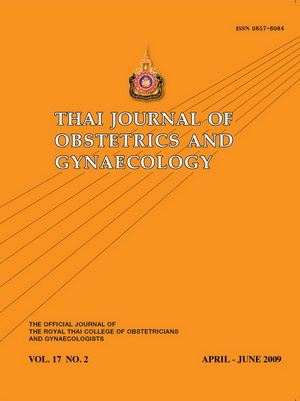Predicting factors for excessive intraoperative blood loss during abdominal hysterectomy for benign gynecologic diseases
Main Article Content
Abstract
Objectives: To determine the incidence of excessive intraoperative blood loss (> 500 ml) and to examine risk factors associated with excessive blood loss during abdominal hysterectomy for benign gynecologic conditions.
Methods: The clinical, operative, and histopathologic data of 597 women who underwent simple abdominal hysterectomy for benign gynecologic conditions at Maharaj Nakorn Chiang Mai hospital from January 2004 to December 2006 were retrospectively reviewed. Association of the clinico-pathologic factors and excessive blood loss was examined by using the chi-squared test or Fisher’s exact test as appropriate. Logistic regression analysis was performed to determine the independent factors that were associated with an increased risk of excessive blood loss.
Results: The mean blood loss was 750 ml (350-1400). One hundred and seventy seven (29.6%) patients had excessive blood loss. From univariate analysis, age < 50 years, parity < 2, uterine weight > 250 gm, BMI > 25 kg/m2, preoperative diagnosis of endometriosis or tuboovarian abscess, and premenopause were associated with excessive blood loss. Multivariate analysis identified preoperative diagnosis, uterine weight, BMI, and menopausal status as independent factors determining the likelihood of excessive blood loss.
Conclusion: Approximately one-third of the patients in this study had excessive blood loss. The chance of having excessive intraoperative blood loss can be predicted preoperatively by examining various clinical factors. This would lead to appropriate counseling, patient preparation, blood components request, and consultation planning.

